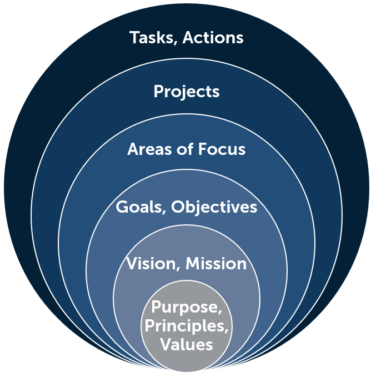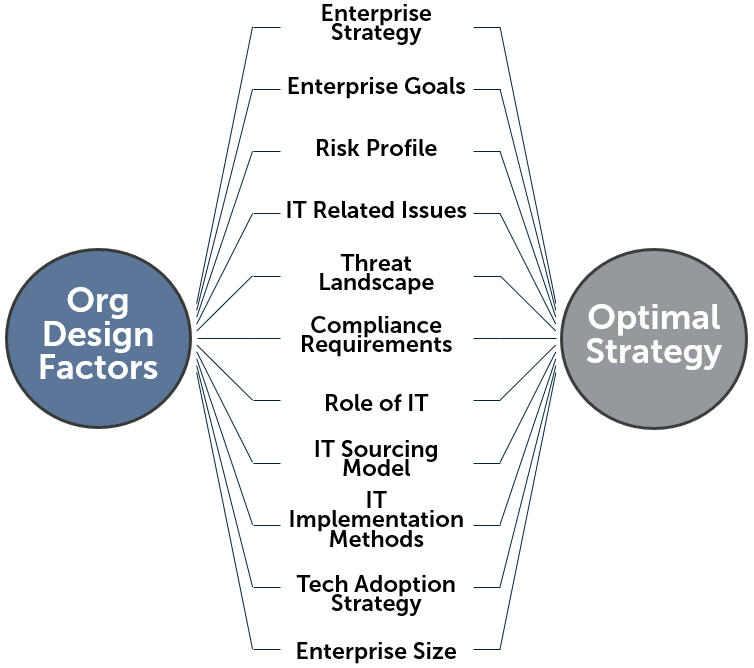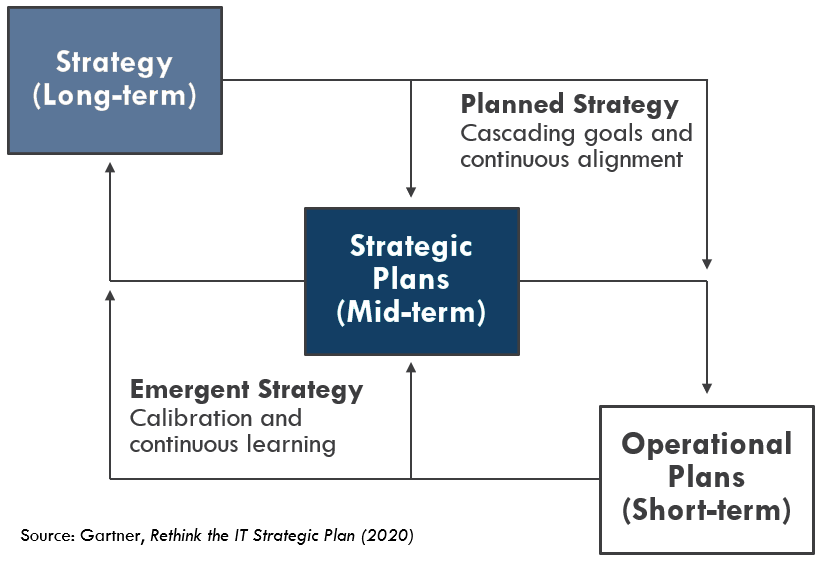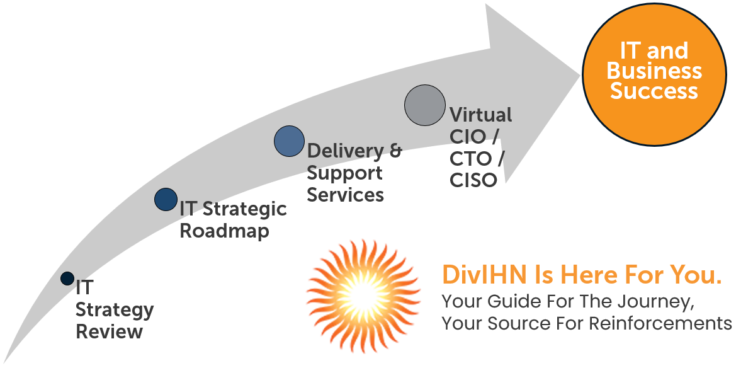The key to surviving and thriving while navigating the rocky landscape of modern IT, is to start with a great information technology strategy. The main goal, or ‘Prime Directive’, of any IT Strategy is to provide as much value as possible in support of the organization’s overall mission and business goals, across multiple dimensions and responsibilities.
While it sounds simple enough, that is certainly a tall order. For starters, the phrase ‘all areas of responsibility’ sounds potentially daunting. What are all the areas of responsibility of IT that any organization should consider?
It turns out that a lot of smart people have written a lot of great stuff over the years, trying to answer that question. It is useful to draw from the best of them in identifying all the relevant aspects and considerations that fall under the umbrella of “information technology” and its related responsibilities.
Focus Horizons and Goals Cascade
So, where do you start? The development of a comprehensive strategy can be approached from many altitudes, as there are multiple strategic aspects and considerations for any organization. It is useful to think about the approach to ‘strategy’ in terms of ‘Horizons of Focus’, or levels of perspective.
At the top level, the organization’s overall purpose, principles, and values
inform its vision and mission. This is where the concept of ‘ideal’, in the
context of organization’s specific situation, is defined. This is usually the domain of owners, Boards of Directors or Trustees, or other governing bodies. More progressive leadership will include and consider input from all levels of the organization (aka ‘OpenStrategy’).


Regardless of how the upper horizons are handled, it is at the level of ‘Goals and Objectives’ that strategy really starts. Translating the hopes and desires of Upper Management into actionable roadmaps to success is the purpose of strategy. The output of the IT Strategy process is a hierarchical, prioritized set of goals for information technology investment and utilization across the organization. The key metric is the resulting impact of information technology investment on the overall success of the organization.
The difference between a ‘Great Strategy’ and a ‘Poor Strategy’ is the size of the gap between the current existing strategy and the ‘Ideal Strategy’ for the organization.
The (Imaginary) Ideal Strategy
If we distill the concept of “strategy” down to its simplest form, we can consider that the purpose of a strategy is to find solutions to problems.

In other words, you can take any problem, apply a relevant strategy, and come up with a solution. The better the strategy (for the problem at hand), the better the solution.
Now let us take that to its logical conclusion, by starting with the original problem and applying a theoretically Ideal Strategy to it. What would the outcome be? It would be a theoretically Perfect Solution!

Of course, it would only be possible to create an “ideal strategy” that yields “perfect solutions” to any problem if you lived an Imaginary World. Even though “ideal” is not achievable in real life, it is still very useful as a target to strive for.
So then, what would our “(Imaginary) Ideal Strategy” include? It would have to take all relevant and specific considerations into account, mix them in flawless proportion given the organization’s situation, and then prescribe the exact right goals, objectives and steps to achieve complete success, for every problem.
These are many of the attributes that would have to all be in perfect harmony, in the Imaginary World of our Ideal Strategy.

These are many of the attributes that would have to all be in perfect harmony, in the Imaginary World of our Ideal Strategy.
The True Goal – Optimal Strategy
Let us take as a given that the “Ideal Strategy” is an unattainable vision of ultimate perfection. We could then assume that if it were possible to create such a thing, it would likely take an infinite amount of resources. Unless your firm actually has unlimited resources, it usually makes sense to find the point (often in the vicinity of the Point of Diminishing Returns) at which you get the most “bang for your buck” in terms of your investment
in “idealness”.
The goal, then, should be to strive for Optimal IT Strategy – that is to say, not perfect, but which is best suited to your particular organization, given its available resources and relevant constraints.

How can you know if your IT Strategy is optimal, or close enough?
- First, measure it and compare to the ‘(Imaginary) Ideal Strategy’ model.
- Then, determine how close to ‘ideal’ it is best for you to be, on multiple relevant dimensions.
- Finally, define and prioritize the goals and objectives needed to close the gaps between your current IT Strategy and the optimal one.
The relevant dimensions are the “Design Factors” that influence the design of an enterprise’s governance and management system (strategy implementation). By identifying the current posture of your organization for each of the “Design Factors”, you can effectively map your organizations unique elements, compare them to the “ideal values”, and determine how small or big the gaps are. The “optimal values” for each “Design Factor” will simply be the “target maturity level” that is most appropriate for the organization, considering the applicable priorities and resource constraints.
The Road(map) To Optimal IT Strategy
Being clear about the difference between having “insight” and having “a plan” is critical, especially in a highly dynamic environment.
Strategy defines the long-term direction of the enterprise, articulating what the enterprise will do to compete and succeed in its chosen markets or, for the public sector, what the agency will do to achieve its mission.
Strategic Plans define how the enterprise will realize its long-term ambitions. They identify the roadmap of initiatives and portfolio of investments required to achieve the objectives defined in the strategy.
Operational Plans deal with the execution of specific projects and changes, as well as any operational tasks not contained in the strategic plan, such as regular software upgrades or hardware maintenance.

It is important to recognize that the path to the blissful world of an Optimal IT Strategy is certainly not an easy one. In fact, even the first step of recognizing that your current IT Strategy might just have a fatal flaw or two, can be very difficult in itself. All the additional steps on the path won’t get easier – the deep introspection, honest assessment, and committing to strategic change will require commitment and perseverance. There will be unforeseen obstacles, and possibly painful lessons, on the road to enlightenment.
What If You Need Help?
If you and your team have all the requisite knowledge and capabilities, plus the bandwidth needed for the effort, great! We wish you unbridled success and look forward to telling your happy story someday.
If, however, you would benefit from an expert to guide you on your journey, plus additional resources to bolster your team, DivIHN is always here to be your trusted advisor and partner along the way.

DivIHN’s unique approach to information technology strategy, and our proprietary methodology for creating optimized strategic roadmaps, starts with the vast collective experience of our team. That’s over 150 years’ worth of combined tenure. We then add healthy doses of wisdom and resources from several industry-leading frameworks, best practices, and authoritative sources of relevant research, data and guidance. The result is a recipe for measurable business impact and predictable success.




